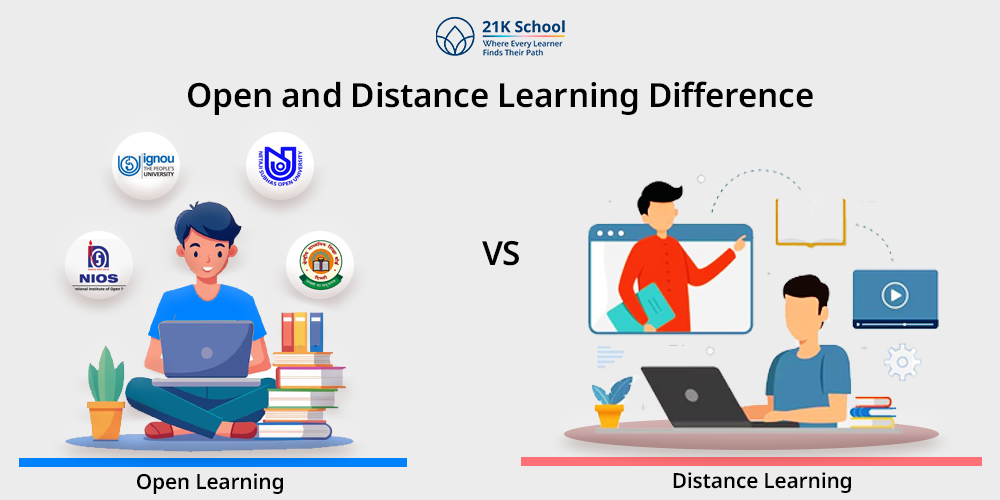
Do you know how open and distance learning are different concepts?
Open and distance learning is an educational system that focuses on providing flexible and remote education . Both methods of learning allow students to study at their own pace and time without attending regular classes.
Open and distance learning provides students the autonomy to study as per their own interests and desires. Many people consider open learning and distance education the same thing because of its shared features; however, both are different concepts.
Open education provides open access to education, which allows students to participate in the teaching and learning process from geographical boundaries.
On the other hand, distance education provides a structured learning environment but in a remote setting, enables students to learn from their homes.
Mostly open and distance learning refers to open schools and educational institutions such as National Institute of Open Schooling (NIOS), Indira Gandhi National Open University (IGNOU), Netaji Subhas Open University (NSOU) and so on.
Contents
What is Open Learning?
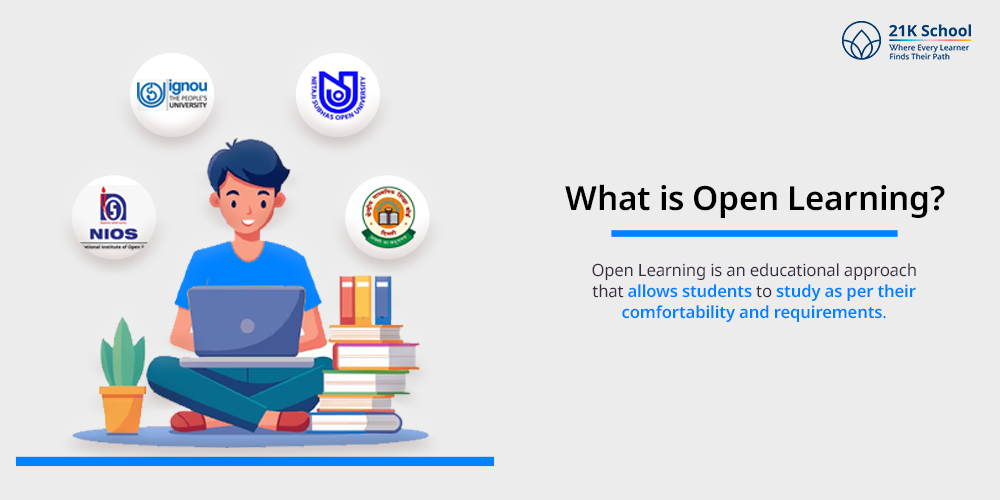
Open Learning is an educational approach that allows students to study as per their comfortability and requirements. Open learning, sometimes referred to as open schools, is a particular kind of education created especially for children who are unable to attend regular schools.
Open learning also uses digital tools and e-resources to provide students with learning materials. To accommodate students’ various needs open learning offers flexible learning opportunities.
Open learning refers to open schools such as NIOS, IGNOU, NSOU, CBSE, Open School, State Open Boards and others that exist in India. All students have equal access to education through open education, regardless of barriers or physical limitations.
Open school allows children to share resources, experiences and knowledge, which foster teamwork and collaboration skills .
What is Distance Education?
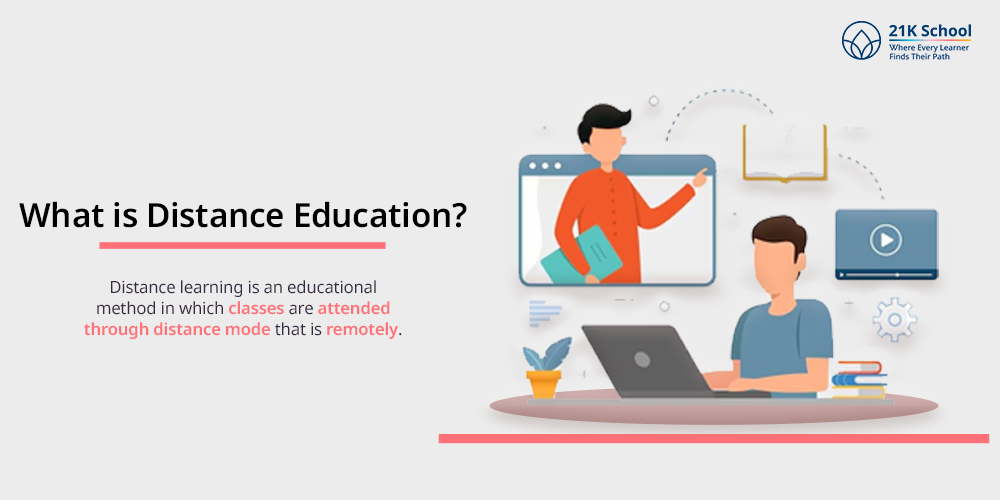
Distance learning is an educational method in which classes are attended through distance mode that is remotely. Sometimes, distance education is also referred to as online learning or remote learning.
The goal of distance education is to provide instruction with the help of digital resources. Distance learning uses a wide range of technologies to transmit learning materials and promote communication.
Students can engage in their studies from anywhere in the world. One of the key benefits of distance learning is that it allows students to balance their studies with responsibilities to their families, jobs and other commitments.
This method of learning provides flexibility to students to choose when and where they want to study. Many distance learning programs allow students to study at their own pace, which enables them to concentrate more on challenging subjects or complete simpler assignments more quickly.
Open and Distance Learning Difference – Detailed Comparison
Open and distance learning are both different concepts but share some common features of remote and flexible learning.
Open learning enables students to study as per their convenience and schedule; on the other hand, distance education provides a structured learning environment with formal education.
Both methods of education have their own style of learning and assessment. Here is a detailed comparison between open and distance learning.
| Aspect | Open Learning | Distance Learning |
| Definition | Open learning is a flexible educational approach that breaks down barriers to education like time location and prior qualifications by prioritizing learner choice and access. | Distance learning is the use of technology to enhance learning between students and teachers who are physically separated. It involves learning remotely often through online platforms as opposed to in a traditional classroom. |
| Assessment Method | Open learning uses formative and summative assessment methods to evaluate students’ performance. | Distance learning uses a summative assessment method, which includes exams, projects or tests, which is used to evaluate students’ performance. |
| Flexibility | Open learning is flexible in nature as it is a less structured and student centric approach. This gives flexibility to students to appear for the exams whenever they want. | Distance learning has a structured learning environment, due to which it becomes less flexible and doesn’t provide much autonomy to students. |
| Type | Open learning is less structured, which makes it flexible and accessible for every student to enroll in the classes without any hindrances. | Distance education has a structured learning environment and emphasises on formal studies. This nature of learning makes it less flexible and more rigid for students. |
| Example | Examples of open learning are open schools such as NIOS, NSOU, IGNOU, etc. | Examples of Distance education are private and government schools that provide distance education such as IMTS, Amity School, etc. |
Here you can check in detail the differentiation of open learning and distance learning.
1. Study Materials
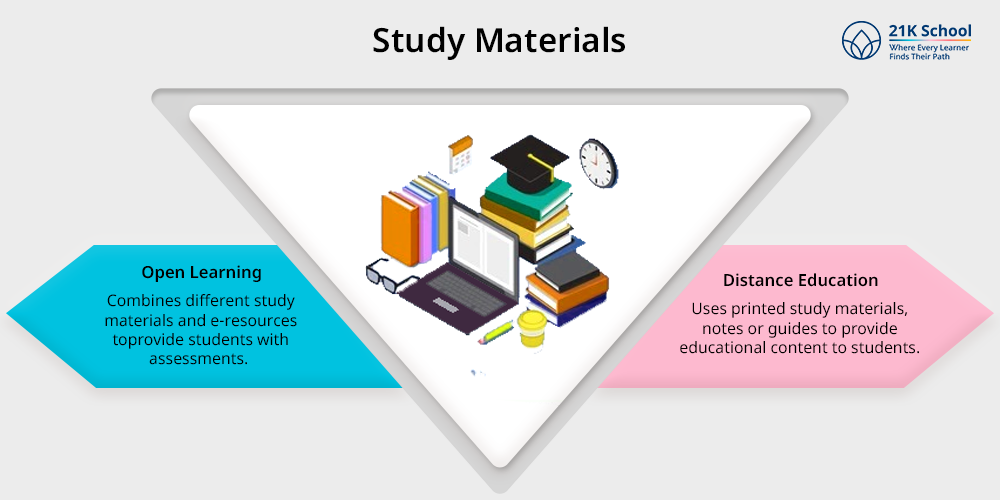
- Open Learning: Open learning combines different study materials and e-resources to provide students with assessments. Through open learning, students can study through e-learning platforms or recorded videos or printed information. However, open learning mostly denotes self-studies or uses digital resources.
- Distance Education: Distance education uses printed study materials, notes or guides to provide educational content to students. In distance education, students learn on their own, with the help of notes or other materials.
However, many educational institutions providing distance education also provide online learning, which enables students to study with the help of virtual learning platforms.
2. Social Interaction
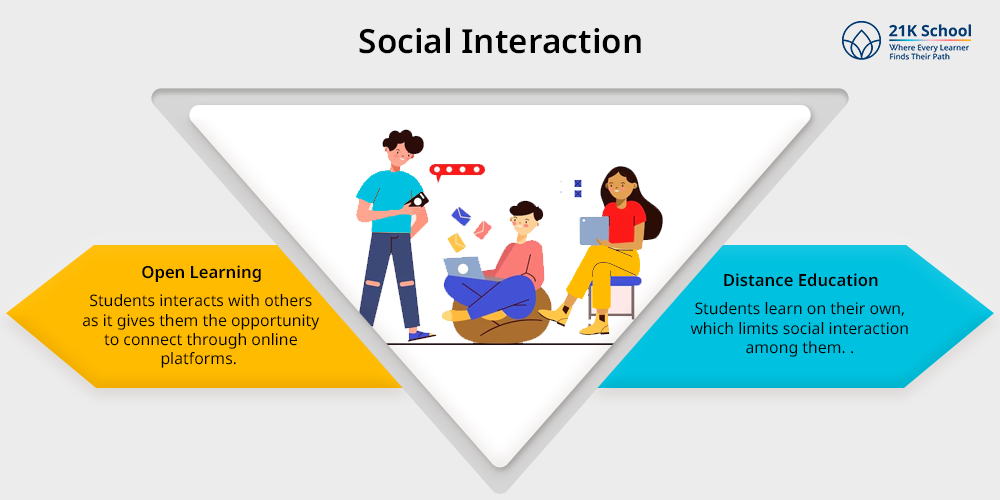
- Open Learning: Open learning allows students to interact with others as it gives them the opportunity to connect through online platforms. Through open learning, students can participate in online group projects , discussion boards, community programs and so on. This promotes a collaborative learning environment and prepares students for social interaction.
- Distance Education: Distance education limits social interaction, as in distance learning, students learn on their own, which limits social interaction among them. Due to limited social interaction, students develop social isolation, which hampers their communication skills .
3. Assessment Method
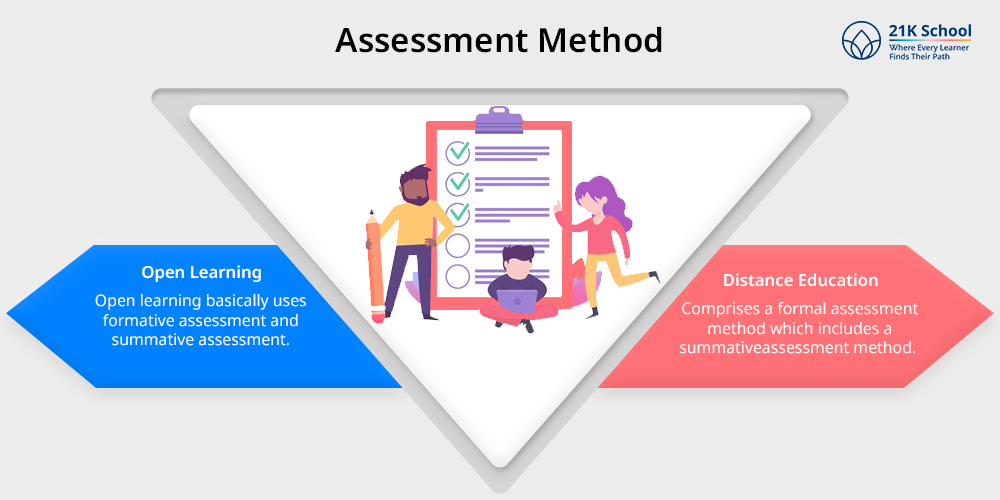
- Open Learning: The Assessment method of open learning basically uses formative assessment and summative assessment. In this method, students are evaluated based on their performance on project works, exams, discussions, etc. Open learning offers a flexible assessment method.
- Distance Learning: Distance learning comprises a formal assessment method which includes a summative assessment method. In distance education, students are evaluated based on exams, oral tests, or practical work. Distance learning offers structured learning methods.
4. Teaching Method
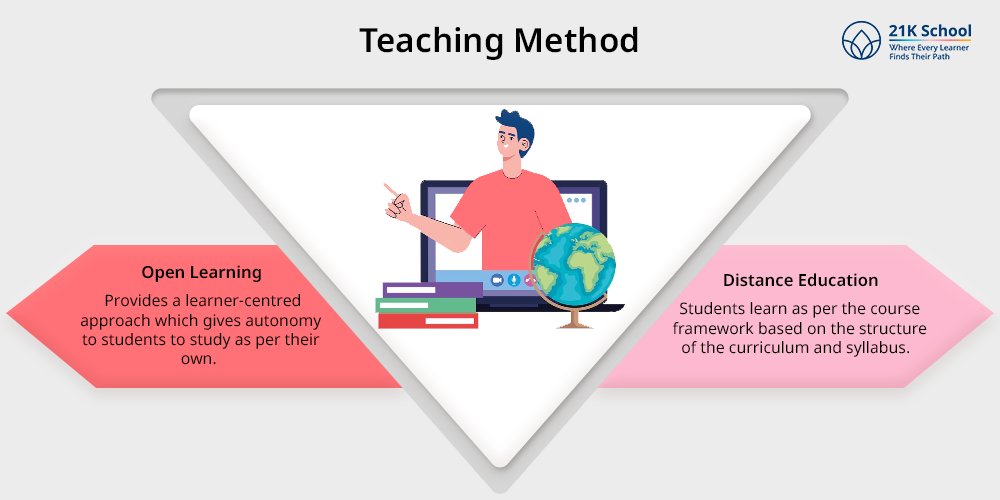
- Open Education: Open learning provides a learner-centred approach which gives autonomy to students to study as per their own. Open learning also uses online resources to teach students, which makes learning more fun and engaging.
- Distance Education: Distance education provides a structured learning environment, enabling students to study at their own pace. In distance education, students learn as per the course framework based on the structure of the curriculum and syllabus.
5. Education Type
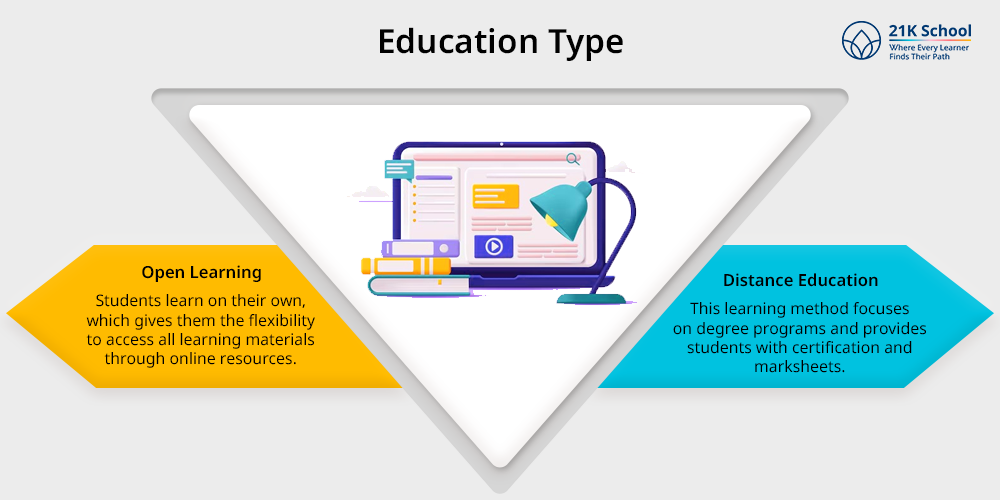
- Open Education: Open education provides a flexible approach to learning that enables students to study as per their own flexibility. In open learning, students learn on their own, which gives them the flexibility to access all learning materials through online resources. Open learning is less structured and formal, which makes it accessible to every individual.
- Distance Education: Distance education provides a structured learning environment with formal education. This learning method focuses on degree programs and provides students with certification and marksheets. It conducts exams in order to assess students’ performance.
6. Structure
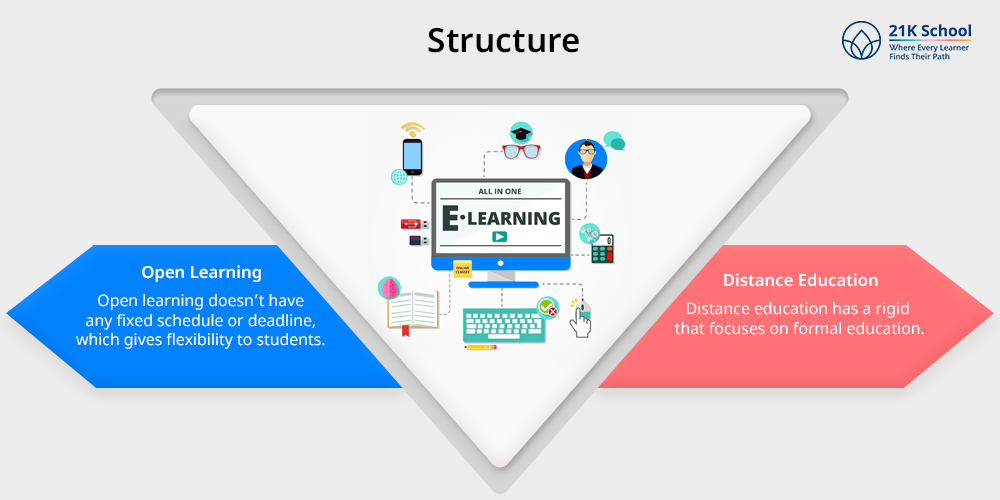
- Open Learning: Open learning is less structured and more flexible, which enables students to learn at their own pace and schedule. Open learning doesn’t have any fixed schedule or deadline, which gives flexibility to students to appear for the exams whenever they want.
- Distance Education: Distance education has a rigid structure that focuses on formal education. This learning method conducts scheduled exams and assessments, in which students have to appear on the same day for the examination.
Final Note
Open and distance learning are two distinct but complementary approaches that fall under the broader umbrella of open and distance learning.
With an emphasis on flexibility, accessibility and a learner-centred methodology, open learning allows students to collaborate with peers in a dynamic virtual environment and engage with a variety of digital resources.
This approach serves a diverse student body, including non-traditional students and fosters a sense of community through interactive platforms. On the other hand, distance learning typically follows a more conventional and structured educational model, often utilising printed materials and scheduled tests.
